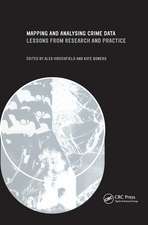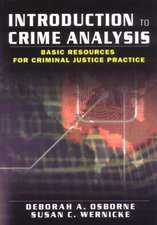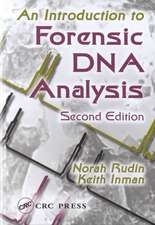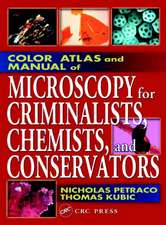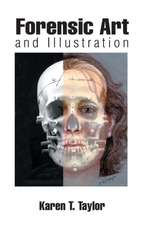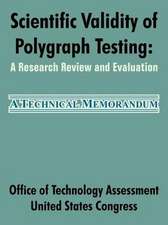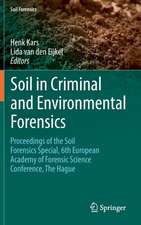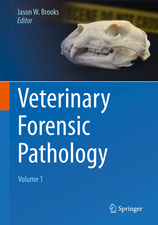P5 Medicine and Justice: Innovation, Unitariness and Evidence
Editat de Santo Davide Ferraraen Limba Engleză Hardback – 9 apr 2018
The unitariness of the “Bio-Medicolegal Sciences”, historically founded on the accuracy and rigor of the methods of ascertainment and criteria of evaluation, should be re-established on the basis of molecular evidence, and used to promote Personalized Justice.
Taken together, the book’s conclusions and future perspectives outline a vision of transdisciplinary innovation and future evidence in the framework of personalized justice.
| Toate formatele și edițiile | Preț | Express |
|---|---|---|
| Paperback (1) | 1064.19 lei 38-44 zile | |
| Springer International Publishing – 10 dec 2018 | 1064.19 lei 38-44 zile | |
| Hardback (1) | 1240.30 lei 6-8 săpt. | |
| Springer International Publishing – 9 apr 2018 | 1240.30 lei 6-8 săpt. |
Preț: 1240.30 lei
Preț vechi: 1512.57 lei
-18% Nou
Puncte Express: 1860
Preț estimativ în valută:
237.36€ • 246.89$ • 195.96£
237.36€ • 246.89$ • 195.96£
Carte tipărită la comandă
Livrare economică 14-28 aprilie
Preluare comenzi: 021 569.72.76
Specificații
ISBN-13: 9783319670911
ISBN-10: 3319670913
Pagini: 780
Ilustrații: XXIII, 635 p. 126 illus., 47 illus. in color.
Dimensiuni: 155 x 235 mm
Greutate: 1.09 kg
Ediția:1st ed. 2017
Editura: Springer International Publishing
Colecția Springer
Locul publicării:Cham, Switzerland
ISBN-10: 3319670913
Pagini: 780
Ilustrații: XXIII, 635 p. 126 illus., 47 illus. in color.
Dimensiuni: 155 x 235 mm
Greutate: 1.09 kg
Ediția:1st ed. 2017
Editura: Springer International Publishing
Colecția Springer
Locul publicării:Cham, Switzerland
Cuprins
FOREWORD.-
PREFACE (S.D. Ferrara).-
PART 1: PERSONALIZED MEDICINE AND JUSTICE.-
Chapter 1: Scientific Evidence and Proof. Towards a Personalized Justice (C.J. Tarfusser).-
PART 2: P4 PERSONALIZED MEDICINE - SCIENTIFIC-TECHNOLOGICAL INNOVATION AND EPISTEMOLOGICAL PERSPECTIVES.-
Chapter 2: Metabolomics and Molecular Imaging in the Post-Genomic Era (L. Illig, T. Illig).-
Chapter 3: The origin of Personalized Medicine and the Systems Biology Revolution (M. Carraro, C.E. Tosatto, R. Rizzuto).-
Chapter 4: Epistemological and Ethical Implications of the P4 Revolution (G. Zaccaria).-
PART 3: INNOVATION, UNITARINESS AND EVIDENCE - BIO-MEDICOLEGAL AND CRIMINOLOGICAL SCIENCES.-
Chapter 5: Bio-Medicolegal Sciences (S.D. Ferrara).-
Chapter 6: Criminological Sciences (K. Kiehl).-
Chapter 7: From Scientific Evidence to Scientific Proof: Daubert Standard and Medi
cal Standard of Care (G. Forti).-PART 4: INNOVATION, UNITARINESS AND EVIDENCE - FORENSIC PATHOLOGY AND ANTHROPOLOGY.-
Chapter 8: Forensic Pathology. Historical Roots and Modern Evolution (S. Pollak).-
Chapter 9: Forensic Pathology and Malpractice in Cardiac Surgery (M. Montisci).-
Chapter 10: Current Practice of Forensic Anthropology on Dead Bodies (M.A. Verhoff, F. Ramsthaler).-
Chapter 11: New Molecular and Imaging Innovations in Forensic Pathology (T. Kondo).-
Chapter 12: Post-Mortem Anthropology and Trauma Analysis (C. Cattaneo, A. Cappella, E. Cunha).-
PART 5: INNOVATION, UNITARINESS AND EVIDENCE - CLINICAL LEGAL AND FORENSIC MEDICINE IN LIVING PERSON - VIOLENCE - CRIMINOGENESIS AND PERSONAL INJURY.-
Chapter 13: Humanitarian Forensic Action. A new Field of Application of Forensic Science (D.N. Vieira).-
Chapter 14: Omics and Functional Imaging in the understanding of Anti
social Behavior (P. Pietrini, G. Rota, S. Pellegrini).-Chapter 15: Current Evidence in Personal Injury and Torture Medicine (M. Lorente Acosta).-
Chapter 16: Current and Future Evidence in Personal Injury Ascertainment under Criminal Law (R. Dettmeyer).-
Chapter 17: Forensic Humanitarian Action. Considerations for Future (D. Ubelaker).-
Chapter 18: Ascertainment of Adult Asylum Seekers (S. Visentin, G. Pelletti).-
PART 6: INNOVATION, UNITARINESS AND EVIDENCE - CLINICAL LEGAL AND FORENSIC MEDICINE IN LIVING PERSON - PERSONAL INJURY AND DAMAGE EVALUATION UNDER CIVIL LAW.-
Chapter 19: Detection of Malingering in Psychic Damage Ascertainment (G. Sartori, A. Zangrossi, G. Orrù, M. Monaro).-
Chapter 20: Current and Future Evidence in Personal Damage Evaluation (G. Mendelson, D. Mendelson).-
PART 7: INNOVATION, UNITARINESS AND EVIDENCE - CLINICAL LEGAL AND FORENSIC MEDICINE IN LIVING PERSON -
;;;;;;;MALPRACTICE AND MEDICAL LIABILITY. INJURY AND DAMAGE.-Chapter 21: International Juridical Overview on Personal Injury Compensation (G. Comandé).-
Chapter 22: New Methods of Ascertainment in Medical Malpractice in Living Persons (T. Bajanowski).-
Chapter 23: Anatomical Variability and Medical Responsibility. Implications in the Methods of Ascertainment and Criteria of Evaluation (A. Porzionato).-
Chapter 24: Current and Future Evidence in Medical Malpractice (P. Vanezis, S. Prior).-
PART 8: INNOVATION, UNITARINESS AND EVIDENCE - CLINICAL LEGAL AND FORENSIC MEDICINE IN LIVING PERSON - PERSONAL IDENTIFICATION AND AGE ESTIMATION.-
Chapter 25: Historical Routes and Current Practice for Personal Identification (E. Cunha, C. Cattaneo).-
Chapter 26: Radiodiagnostic and Molecular Innovation in Personal Identification (S. Grabherr, T. Uldin, F. Dedouit).-
Chapt
er 27: DNA-Based Methods for Age Estimation (M. Cassina, M. Clementi).-PART 9: INNOVATION, UNITARINESS AND EVIDENCE - FORENSIC GENETICS AND GENOMICS.-
Chapter 28: From Hemogenetics to Forensic Genomics (A. Carracedo).-
PART 10: INNOVATION, UNITARINESS AND EVIDENCE - FORENSIC TOXICOLOGY.-
Chapter 29: Post-Modern Medico-legal and Forensic Toxicology (H. Maurer).-
Chapter 30: From Drug Identification to Systems Toxicology (D. Favretto).-
Chapter 31: Metabolomics and Omic-related Sciences in Forensic Toxicology: a Bridge towards Forensic Medicine? (N. Bararpour, F. Sporkert, M. Augsburger, A. Thomas).-
Chapter 32: Medicines and Driving. Personalized Medicine and Medical liability (R. Snenghi, A. Amagliani).-
Chapter 33: Single Hair Analysis: Monitoring Concept for P4 Implementation (M. Baumgartner).-
PART 11: INNOVATION, UNITARINESS AND EVIDENCE - FORENSIC IMAGING.-
Chapter 34: History and Current State of Forensic Imaging (H. Vogel).-Chapter 35: Advances in Post-Mortem Forensic Imaging (F. Dedouit, L. Campana, T. Uldin, S. Grabherr).-
Chapter 36: Micro and Nano Imaging in Forensic Pathology (G. Cecchetto).-
Chapter 37: Advances in Clinical Forensic Imaging (K. Yen, A. Krauskopf).-
Chapter 38: Future Evidence in Forensic Imaging (G.N. Rutty, B. Morgan).-
PART 12: EPICRISIS, CONCLUSIONS & FUTURE PERSPECTIVES.-
Chapter 39: Transdisciplinary Innovation and Future Evidence (S.D. Ferrara, G. Forti, J.C. Tarfusser).-
Acknowledgments.-
Index.
Notă biografică
Santo Davide Ferrara is a Full Professor of Legal Medicine and Forensic Toxicology, Director of the Department of Legal and Occupational Medicine, Toxicology and Public Health, Past Dean of the School of Medicine at the University of Padua, President of the Veneto Regional Foundation – School of Public Health, President of the International Academy of Legal Medicine, Vice President of the European Council of Legal Medicine, Past President of the European Academy of Legal Medicine, and editor of the International Journal of Legal Medicine and Rechtsmedizin. Professor Ferrara is a recipient of numerous international and national scientific awards, and director of various international scientific projects and UN and WHO consultancy programs. He has authored more than 400 articles and written or edited a number of monographs covering diverse fields in the bio-medicolegal sciences and including Doping Antidoping (Piccin, Padova, 2004), Malpractice and Medical Liability (Springer, 2013), and Personal Injury and Damage Ascertainment under Civil Law (Springer, 2016).
Textul de pe ultima copertă
This book describes the state of the art and future prospects of the most important bio-medicolegal subdisciplines in the post-genomic framework of personalized medicine. Focusing on the three main themes Innovation, Unitariness and Evidence, the book addresses a wide range of topics, including: Bio-Medicolegal and Criminological Sciences, Forensic Pathology and Anthropology, Clinical and Forensic Medicine in Living Persons (from Interpersonal Violence to Personal Injury and Damage, Malpractice, Personal Identification and Age Estimation), Forensic Genetics and Genomics, and Toxicology and Imaging.
The unitariness of the “Bio-Medicolegal Sciences”, historically founded on the accuracy and rigor of the methods of ascertainment and criteria of evaluation, should be re-established on the basis of molecular evidence, and used to promote Personalized Justice.
Taken together, the book’s conclusions and future perspectives outline a vision of transdisciplinary innovation and future evidence in the framework of personalized justice.
The unitariness of the “Bio-Medicolegal Sciences”, historically founded on the accuracy and rigor of the methods of ascertainment and criteria of evaluation, should be re-established on the basis of molecular evidence, and used to promote Personalized Justice.
Taken together, the book’s conclusions and future perspectives outline a vision of transdisciplinary innovation and future evidence in the framework of personalized justice.
Caracteristici
The first book that addresses the interrelation between P5 Medicine and Justice
Presents the state of the art and the future perspectives of a wide range of subdisciplines of the Bio-Medicolegal Sciences
Provides a vision of and evidence for achieving personalized justice
Presents the state of the art and the future perspectives of a wide range of subdisciplines of the Bio-Medicolegal Sciences
Provides a vision of and evidence for achieving personalized justice




